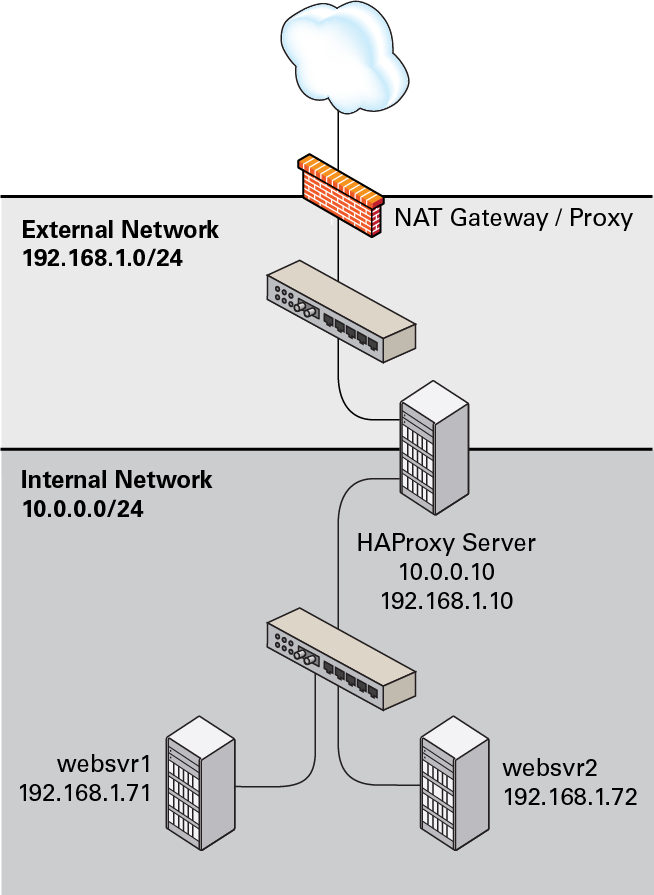The software described in this documentation is either in Extended Support or Sustaining Support. See https://www.oracle.com/us/support/library/enterprise-linux-support-policies-069172.pdf for more information.
Oracle recommends that you upgrade the software described by this documentation as soon as possible.
The following example uses HAProxy to implement a front-end server that balances incoming requests between two back-end web servers, and which is also able to handle service outages on the back-end servers.
Figure 17.1 shows
an HAProxy server (10.0.0.10), which is
connected to an externally facing network
(10.0.0.0/24) and to an internal network
(192.168.1.0/24). Two web servers,
websvr1 (192.168.1.71) and
websvr2 (192.168.1.72), are
accessible on the internal network. The IP address
10.0.0.10 is in the private address range
10.0.0.0/24, which cannot be routed on the
Internet. An upstream network address translation (NAT) gateway or
a proxy server provides access to and from the Internet.
You might use the following configuration in
/etc/haproxy/haproxy.cfg on the server:
global
daemon
log 127.0.0.1 local0 debug
maxconn 50000
nbproc 1
defaults
mode http
timeout connect 5s
timeout client 25s
timeout server 25s
timeout queue 10s
# Handle Incoming HTTP Connection Requests
listen http-incoming
mode http
bind 10.0.0.10:80
# Use each server in turn, according to its weight value
balance roundrobin
# Verify that service is available
option httpchk OPTIONS * HTTP/1.1\r\nHost:\ www
# Insert X-Forwarded-For header
option forwardfor
# Define the back-end servers, which can handle up to 512 concurrent connections each
server websvr1 192.168.1.71:80 weight 1 maxconn 512 check
server websvr2 192.168.1.72:80 weight 1 maxconn 512 check
This configuration balances HTTP traffic between the two back-end
web servers websvr1 and
websvr2, whose firewalls are configured to
accept incoming TCP requests on port 80.
After implementing simple
/var/www/html/index.html files on the web
servers and using curl to test connectivity,
the following output demonstrate how HAProxy balances the traffic
between the servers and how it handles the
httpd service stopping on
websvr1:
$while true; do curl http://10.0.0.10; sleep 1; doneThis is HTTP server websvr1 (192.168.1.71). This is HTTP server websvr2 (192.168.1.72). This is HTTP server websvr1 (192.168.1.71). This is HTTP server websvr2 (192.168.1.72). ... This is HTTP server websvr2 (192.168.1.72). <html><body><h1>503 Service Unavailable</h1> No server is available to handle this request. </body></html> This is HTTP server websvr2 (192.168.1.72). This is HTTP server websvr2 (192.168.1.72). This is HTTP server websvr2 (192.168.1.72). ... This is HTTP server websvr2 (192.168.1.72). This is HTTP server websvr2 (192.168.1.72). This is HTTP server websvr2 (192.168.1.72). This is HTTP server websvr1 (192.168.1.71). This is HTTP server websvr2 (192.168.1.72). This is HTTP server websvr1 (192.168.1.71). ...^C$
In this example, HAProxy detected that the
httpd service had restarted on
websvr1 and resumed using that server in
addition to websvr2.
By combining the load balancing capability of HAProxy with the high availability capability of Keepalived or Oracle Clusterware, you can configure a backup load balancer that ensures continuity of service in the event that the primary load balancer fails. See Section 17.10, “Making HAProxy Highly Available Using Keepalived” and Section 17.12, “Making HAProxy Highly Available Using Oracle Clusterware”.
See Section 17.2, “Installing and Configuring HAProxy” for details of how to install and configure HAProxy.


